Clade Lophophorata — The Lophophorate Animals
Characteristics
- Have lophophore: O- or U-shaped ridge with tentacles surrounding mouth
- Tentacles are hollow and ciliated
- Three-part coelom
- U-shaped gut (anus lies outside lophophore in most?)
- Secrete some sort of casing
|
|
Phylum Brachiopoda — Lamp Shells
Characteristics
- Superficially Mollusc-like, with 2-valve shell
- One valve is dorsal, one ventral (mollusc valves are right and left)
- Usually with stalk (pedicle) to attach to substrate
- Lophophore retained within valves; not retractible
- Marine, benthic
- Hyolithids are probably unusual stem-brachiopods
|

Lamp Shells, Lingula sp., preserved specimens
See also labeled photo
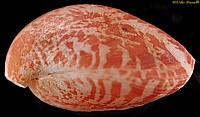
Sanguine Lamp Shell, Frenulina sanguinolenta, shell in lateral view
|
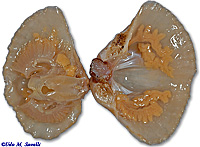
Articulate Brachiopod, Terebratella sp., preserved specimens
See also labeled photo
|
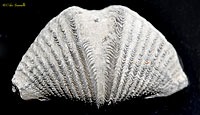
Brachiopod Fossil, Mucrospirifer sp.; Devonian Period, Canada
|
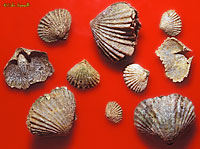
Platystrophia sp. brachiopod Fossils; Ordovician, KY
|

Brachiopods of the Naco Formation; Pennsylvanian Period, near Payson, AZ
|
|

Hyolithes hyolithid fossil; note operculum and helen; Middle Cambrian Period, UT
|
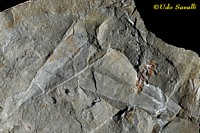
Nevadotheca billingsi hyolithid fossils, Cambrian Period, NV
|
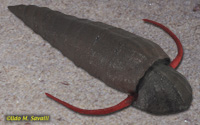
Model of the hyolithid Haplophrentis carinatus; Cambrian Period
|
|
Phylum Phoronida — Horseshoe Worms
Characteristics
- Tube-dwelling worm-like animals
- Lophophore is retractible
- Typically around 12 cm long
- Hemoglobin in blood imparts red color
- 14 species, all are marine
|

Phoronid Worm, Phoronis psammophila, partly extruded from its tube
|
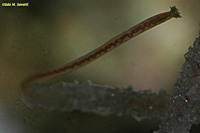
Phoronid Worm, Phoronis psammophila
|

Tentaculite fossils, Tentaculites sp., a possible stem-phoronid; Devonian Period, Ontario
|
|
Phylum Bryozoa (aka Ectoprocta) — Moss Animals
Characteristics
- Lophophore can be protruded or retracted
- Individuals tiny (<1 mm) but always form colonies (via budding)
- Colonies have variety of forms (encrusting, branched, etc.)
- Each individual housed in a secreted casing (Cystid)
- Mostly marine, some fresh-water
|
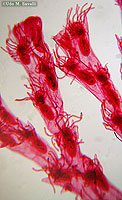
Spiral Bryozoan, Bugula sp., portion of colony; stained whole-mount.
|

Freshwater bryozoan, Pectinatella magnifica, individual zooid; stained whole-mount, 40x
See also labeled photo
|

Unidentified bryozoan colony, feeding with lophophores extended
|
|
|
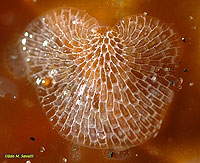
Lacy-crust Bryozoan colony, Membranipora villosa; CA
|
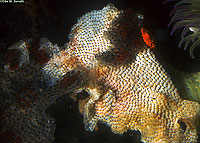
Unidentified bryozoan colonies
|
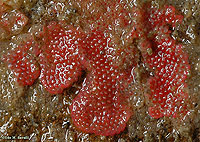
Derby Hat Bryozoan colony, Eurystomella bilabiata; CA
|
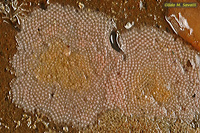
Encrusting Bryozoan colony, Microporella sp.?; La Jolla, CA
|

Unidentified Branching Bryozoan colony; La Jolla, CA
|

Stick Bryozoan colony, Thalamoporella californica; La Jolla, CA
|
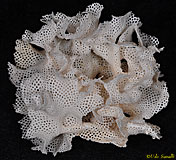
Dried specimen of Lace Bryozoan colony, Triphyllozoon sp.
|
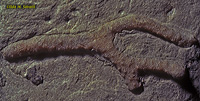
Branching Bryozoan Fossil; Ordovician Period, KY
|
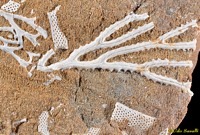
Pseudohornera bifida & Pachydictya kuckersensis Bryozoan Fossils; Ordovician Period, Estonia
|
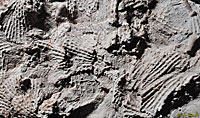
Fenestella sp. bryozoan Fossils; Carboniferous Period, Arizona
|

Archimedes Screw, Archimedes sp.; the flat plates of this sheet-like colony are arranged in a spiral around a central shaft; Carboniferous Period, Alabama
|
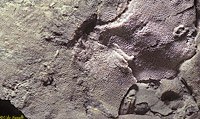
Treptostomatid Bryozoan Fossil; Ordovician Period, KY
|
|
Phylum Entoprocta (Kamptozoa)
Characteristics
- Solitary or form small colonies, often stalked
- Tiny size (usually <2 mm)
- Ring of ciliated tentacles probably homologous to Lophophore mouth and anus
- Anus lies withing ring of tentacles (unlike all other Lophophorates)
- Evolutionary relationships debated, but probably related to Bryozoans
|
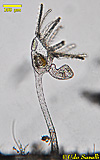
Solitary Entoproct, possibly Loxosoma sp., with bud
|

Solitary Entoproct, possibly Loxosoma sp., tentacles retracted
|
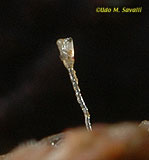
Nodding Head Entoproct, possibly Barentsia sp.; CA
|
|
|





























